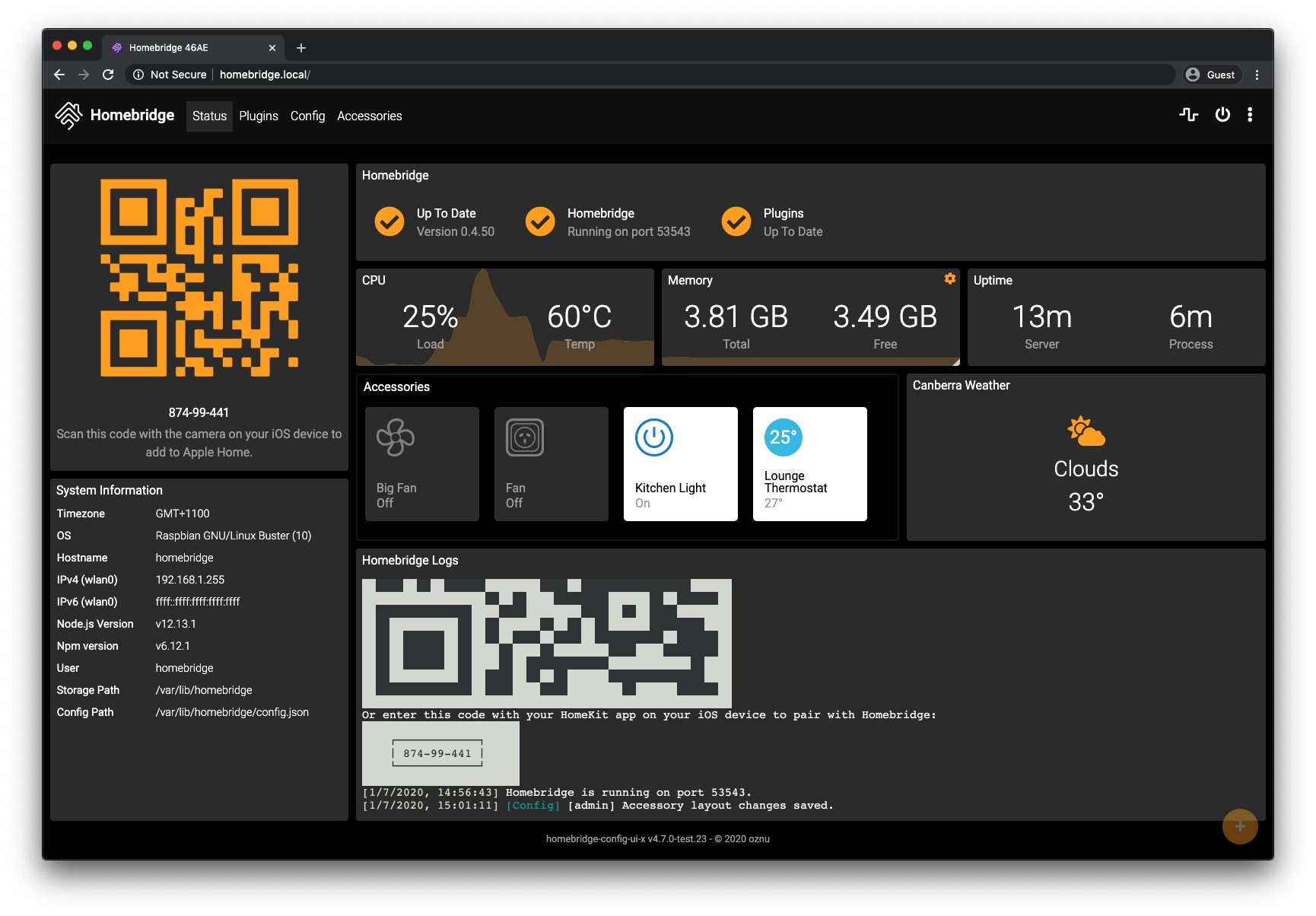We have moved the hosting of the offical homebridge docker image from oznu/homebridge to homebridge/homebridge. Please update your environments as needed to pickup the latest image.
This Ubuntu Linux based Docker image allows you to run Nfarina's Homebridge on your home network which emulates the iOS HomeKit API.
This is a multi-arch image and will run on x86_64, Raspberry Pi 2, 3, 4, Zero 2 W, or other Docker-enabled ARMv7/8 devices. Docker will automatically pull the correct image for your system.
| Image Tag | Architectures | Base Image |
|---|---|---|
| latest, ubuntu | amd64, arm32v7, arm64v8 | Ubuntu 22.04 |
- Running Homebridge with Docker on Linux
- Running Homebridge on a Synology NAS
- Running Homebridge on Unraid
Homebridge requires full access to your local network to function correctly which can be achieved using the --net=host flag.
This image will not work when using Docker for Mac or Docker for Windows due to this and this.
Using Docker Compose (recommended):
- Create the file
docker-compose.yml
version: '2'
services:
homebridge:
image: homebridge/homebridge:latest
restart: always
network_mode: host
volumes:
- ./volumes/homebridge:/homebridge
logging:
driver: json-file
options:
max-size: '10m'
max-file: '1'
healthcheck:
test: curl --fail localhost:8581 || exit 1
interval: 60s
retries: 5
start_period: 300s
timeout: 2s- Start docker with
docker compose updocker run --net=host --name=homebridge -v $(pwd)/homebridge:/homebridge homebridge/homebridge:latestThe parameters are split into two halves, separated by a colon, the left hand side representing the host and the right the container side.
--net=host- Shares host networking with container, required-v /homebridge- The Homebridge config and plugin location, required
-e TZ- for timezone information e.g.-e TZ=Australia/Canberra-e ENABLE_AVAHI- default is1; set to0to prevent the Avahi mDNS service running in the container
This image comes with the Homebridge UI pre-installed and is the easiest way to manage all aspects of Homebridge.
To manage Homebridge go to http://<ip of server>:8581 in your browser. For example, http://192.168.1.20:8581. From here you can install, remove and update plugins, modify the Homebridge config.json and restart Homebridge.
Automated updates of the Homebridge Docker Image using tools such as Watchtower or similar are strongly discouraged and are done so at your own risk.
NOTE - The version of Homebridge IS NOT tied to the version of the container. You can update Homebridge, the Homebridge UI and the Node.js runtime from inside the container.
ffmpeg, with libfdk-aac audio support is included in this image.
If you're seeing errors like the following, your host operating system needs to be updated.
See #434 and #441 for potential solutions.
Node.js[445]: ../src/util.cc:188:double node::GetCurrentTimeInMicroseconds(): Assertion `(0) == (uv_gettimeofday(&tv))' failed.
Aborted (core dumped)
homebridge_1 | s6-svscan: warning: unable to iopause: Operation not permitted
homebridge_1 | s6-svscan: warning: executing into .s6-svscan/crash
homebridge_1 | s6-svscan crashed. Killing everything and exiting.
homebridge | # Fatal error in , line 0
homebridge | # unreachable code
Join the Official Homebridge Discord community and ask in the #docker channel.
Copyright (C) 2023 homebridge Copyright (C) 2017-2022 oznu
This program is free software: you can redistribute it and/or modify it under the terms of the GNU General Public License as published by the Free Software Foundation, either version 3 of the License, or (at your option) any later version.
This program is distributed in the hope that it will be useful, but WITHOUT ANY WARRANTY; without even the implied warranty of MERCHANTABILITY or FITNESS FOR A PARTICULAR PURPOSE. See the GNU General Public License for more details.



